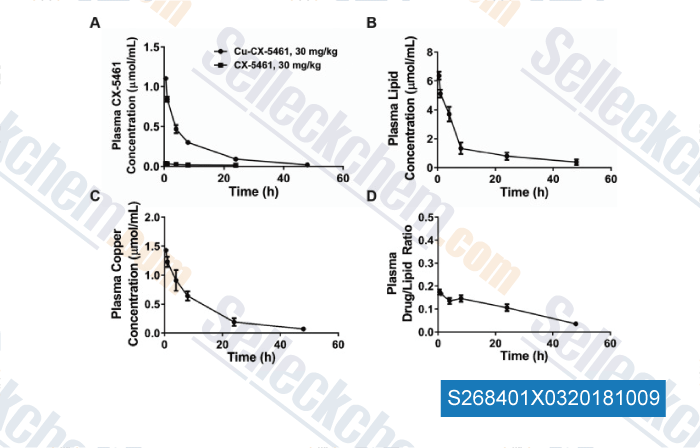|
Toll Free: (877) 796-6397 -- USA and Canada only -- |
Fax: +1-832-582-8590 Orders: +1-832-582-8158 |
Tech Support: +1-832-582-8158 Ext:3 Please provide your Order Number in the email. |
Technical Data
| Formula | C27H27N7O2S |
||||||||||
| Molecular Weight | 513.61 | CAS No. | 1138549-36-6 | ||||||||
| Solubility (25°C)* | In vitro | DMSO | 3 mg/mL (5.84 mM) | ||||||||
| Water | Insoluble | ||||||||||
| Ethanol | Insoluble | ||||||||||
| In vivo (Add solvents to the product individually and in order) |
|
||||||||||
|
* <1 mg/ml means slightly soluble or insoluble. * Please note that Selleck tests the solubility of all compounds in-house, and the actual solubility may differ slightly from published values. This is normal and is due to slight batch-to-batch variations. * Room temperature shipping (Stability testing shows this product can be shipped without any cooling measures.) |
|||||||||||
Preparing Stock Solutions
Biological Activity
| Description | Pidnarulex (CX-5461) is an inhibitor of rRNA synthesis, selectively inhibits Pol I-driven transcription of rRNA with IC50 of 142 nM in HCT-116, A375, and MIA PaCa-2 cells, has no effect on Pol II, and possesses 250- to 300-fold selectivity for inhibition of rRNA transcription versus DNA replication and protein translation. | ||
|---|---|---|---|
| Targets |
|
||
| In vitro | CX-5461 is found to selectively inhibit rRNA synthesis (Pol I IC50=142 nM; Pol II IC50 > 25 μM; selectivity ~200-fold) in the HCT-116 cells. Selective inhibition of rRNA synthesis by CX-5461 is confirmed in two other human solid tumor cell lines; melanoma A375 (Pol I IC50 = 113 nM; Pol II IC50 > 25 μM) and pancreatic carcinoma MIA PaCa-2 (Pol I IC50=54 nM; Pol II IC50 ~25 mM). CX-5461 possesses 250- to 300-fold selectivity for inhibition of rRNA transcription versus DNA replication and protein translation. CX-5461 exhibits broad antiproliferative potency in a panel of cancer cell lines in human cancer cell lines, but has minimal effect on viability of nontransformed human cells. The median EC50 across all tested cell lines is 147 nM, yet all normal cell lines have EC50 values of approximately 5, 000 nM. Evaluation of the antiproliferative dose response for HCT-116, A375, and MIA PaCa-2 cell lines yield EC50 values of 167, 58, and 74 nM. CX-5461 induces autophagy and senescence in solid tumor cancer cells, rather than apoptosis, through a p53-independent process. [1] |
||
| In vivo | CX-5461 is orally bioavailable and demonstrates in vivo antitumor activity against human solid tumors in murine xenograft models. CX-5461 demonstrates significant MIA PaCa-2 TGI with TGI equal to 69% on day 31. Likewise, CX- 5461 demonstrates significant A375 TGI with TGI equal to 79% on day 32. [1] |
Protocol (from reference)
| Kinase Assay: |
|
|---|---|
| Cell Assay: |
|
| Animal Study: |
|
Customer Product Validation

-
Data from [Data independently produced by PLoS One, 2014, 9(8), e104364]

-
Data from [Data independently produced by , , Cell, 2018, 174(2):338-349]

-
Data from [Data independently produced by , , Oncogene, 2015, 10.1038/onc.2015.147]

-
Data from [Data independently produced by , , J Control Release, 2018, 286:1-9]
Selleck's Pidnarulex (CX-5461) has been cited by 76 publications
| Guanine nucleotide biosynthesis blockade impairs MLL complex formation and sensitizes leukemias to menin inhibition [ Nat Commun, 2025, 16(1):2641] | PubMed: 40102405 |
| Role of the NuRD complex and altered proteostasis in cancer cell quiescence [ bioRxiv, 2025, 2025.02.10.637435] | PubMed: 39990343 |
| Senescence suppresses the integrated stress response and activates a stress-remodeled secretory phenotype [ Mol Cell, 2024, 84(22):4454-4469.e7] | PubMed: 39481386 |
| Nucleolar stress caused by arginine-rich peptides triggers a ribosomopathy and accelerates aging in mice [ Mol Cell, 2024, 84(8):1527-1540.e7] | PubMed: 38521064 |
| An RNA damage response network mediates the lethality of 5-FU in colorectal cancer [ Cell Rep Med, 2024, 5(10):101778] | PubMed: 39378883 |
| VAV2 orchestrates the interplay between regenerative proliferation and ribogenesis in both keratinocytes and oral squamous cell carcinoma [ Sci Rep, 2024, 14(1):4060] | PubMed: 38374399 |
| Integrated drug response prediction models pinpoint repurposed drugs with effectiveness against rhabdomyosarcoma [ PLoS One, 2024, 19(1):e0295629] | PubMed: 38277404 |
| Alcohol exposure suppresses ribosome biogenesis and causes nucleolar stress in cranial neural crest cells [ PLoS One, 2024, 19(6):e0304557] | PubMed: 38941348 |
| Systematic Evaluation of Benchmark G4 Probes and G4 Clinical Drugs using three Biophysical Methods: A Guideline to Evaluate Rapidly G4-Binding Affinity [ Chembiochem, 2024, e202400210] | PubMed: 38619969 |
| CX‑5461 potentiates imatinib‑induced apoptosis in K562 cells by stimulating KIF1B expression [ Exp Ther Med, 2024, 27(3):107.] | PubMed: 38356673 |
RETURN POLICY
Selleck Chemical’s Unconditional Return Policy ensures a smooth online shopping experience for our customers. If you are in any way unsatisfied with your purchase, you may return any item(s) within 7 days of receiving it. In the event of product quality issues, either protocol related or product related problems, you may return any item(s) within 365 days from the original purchase date. Please follow the instructions below when returning products.
SHIPPING AND STORAGE
Selleck products are transported at room temperature. If you receive the product at room temperature, please rest assured, the Selleck Quality Inspection Department has conducted experiments to verify that the normal temperature placement of one month will not affect the biological activity of powder products. After collecting, please store the product according to the requirements described in the datasheet. Most Selleck products are stable under the recommended conditions.
NOT FOR HUMAN, VETERINARY DIAGNOSTIC OR THERAPEUTIC USE.
